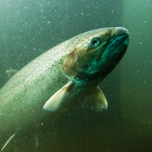April 18, 2014 — Imagine going from sea level to the top of Mount Everest in just a few seconds. That’s the type of pressure change most fish feel when they travel through the turbulent waters near hydropower dams.
Researchers from the U.S. Department of Energy’s Pacific Northwest National Laboratory reported recently in the journal Fisheries that modifying turbines to minimize dramatic shifts in pressure could help protect fish from the phenomenon known as barotrauma — a sudden expansion of the fish’s swim bladder that often leads to injury or death.
To reduce incidence of barotrauma, the researchers recommend considering the species of fish in question and depth of the water where they usually reside when siting new facilities. Once this is known, factors such as the amount of water flowing through a turbine and turbine design can be modified to reduce fish kills. According to the researchers, the most fish-friendly dams are ones that maintain a minimum higher pressure around the turbines.
Working with colleagues from around the world, the researchers are applying lessons learned in three countries — Australia, Brazil and Laos — where hydropower is booming. In Brazil alone, several dozen dams are planned that could impact more than 5,000 species of fish.
“Hydropower is a tremendous resource, often available in areas far from other sources of power and critical to the future of many people around the globe,” said Richard Brown, senior research scientist at PNNL and the lead author of the paper, in a recent news release. “We want to help minimize the risk to fish while making it possible to bring power to schools, hospitals and areas that desperately need it.” Photo by Margaret Killjoy (Flickr | Creative Commons).
Ensia shares solutions-focused stories free of charge through our online magazine and partner media. That means audiences around the world have ready access to stories that can — and do — help them shape a better future. If you value our work, please show your support today.
Yes, I'll support Ensia!
